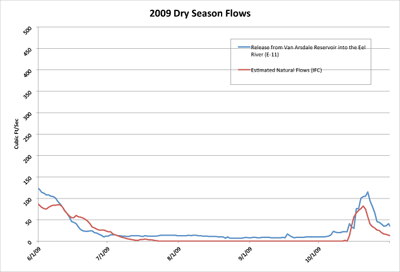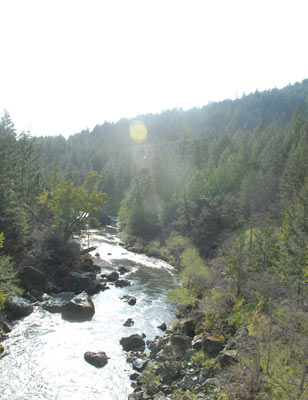Fiction: "The Potter Valley Project has dramatically reduced summer flows on the Mainstem of the Eel River."
 Releases below Cape Horn Dam on the Eel River mimic natural flows and minimum flows are maintained, or exceeded, for the entire summer time period. The summer releases through the Project, into the Potter Valley Powerhouse, would not exist unless winter and spring water was stored in Lake Pillsbury. Before Scott Dam was built there were no summer flows through the Potter Valley Project, and extremely low natural flows below Van Arsdale. To produce power year round, it was necessary to store winter runoff and release it in the summer. The amount of winter water stored is a function of the water year, which runs from October 1 to May 1. Take the winter of 2012-2013 as an example: The cumulative inflow to Lake Pillsbury, over that winter, was over 258,000 ac.ft. The capacity of Lake Pillsbury is just over 74,000 ac.ft. That means that less than 28% of the winter run off above Lake Pillsbury has been stored and that nearly 72% of the rainfall and snowmelt in the upper Mainstem Eel River was released down the Eel River and flowed to the ocean. If Scott Dam did not exist the remaining 28% would have gone down the river to the sea and the natural summer flows would be lower than the current releases being made by PG&E. Where in the world would the high summer flows that the Friends of the Eel River want to see in the Mainstem come from if not Lake Pillsbury? The Mainstem of the Eel River would be even drier than the South Fork, North Fork, Middle Fork or the Van Duzen, in the late summer and fall, if Scott Dam ceased to exist.
Releases below Cape Horn Dam on the Eel River mimic natural flows and minimum flows are maintained, or exceeded, for the entire summer time period. The summer releases through the Project, into the Potter Valley Powerhouse, would not exist unless winter and spring water was stored in Lake Pillsbury. Before Scott Dam was built there were no summer flows through the Potter Valley Project, and extremely low natural flows below Van Arsdale. To produce power year round, it was necessary to store winter runoff and release it in the summer. The amount of winter water stored is a function of the water year, which runs from October 1 to May 1. Take the winter of 2012-2013 as an example: The cumulative inflow to Lake Pillsbury, over that winter, was over 258,000 ac.ft. The capacity of Lake Pillsbury is just over 74,000 ac.ft. That means that less than 28% of the winter run off above Lake Pillsbury has been stored and that nearly 72% of the rainfall and snowmelt in the upper Mainstem Eel River was released down the Eel River and flowed to the ocean. If Scott Dam did not exist the remaining 28% would have gone down the river to the sea and the natural summer flows would be lower than the current releases being made by PG&E. Where in the world would the high summer flows that the Friends of the Eel River want to see in the Mainstem come from if not Lake Pillsbury? The Mainstem of the Eel River would be even drier than the South Fork, North Fork, Middle Fork or the Van Duzen, in the late summer and fall, if Scott Dam ceased to exist.
 Summer flows on the Eel River below the Potter Valley Project are continually maintained because winter water is stored in Lake Pillsbury and can be released as needed for fishery flows. It is the law, and PG&E must report all information regarding inflow to Lake Pillsbury, lake level, releases from storage, natural accretion flows below Scott Dam, diversion through the Project and releases downstream of the fish ladder on a daily basis. The flow releases are based on scientific studies and modeling of the historical naturally occuring flows, conducted over years and years, by fishery biologists and other scientists from the National Marine Fisheries Service, California Department of Fish and Game, US Fish and Wildlife Service, VTN Oregon, Inc, Steiner Environmental Consulting, US Department of the Interior, Oakridge Laboratories and the Federal Energy Regulatory Commission.
Summer flows on the Eel River below the Potter Valley Project are continually maintained because winter water is stored in Lake Pillsbury and can be released as needed for fishery flows. It is the law, and PG&E must report all information regarding inflow to Lake Pillsbury, lake level, releases from storage, natural accretion flows below Scott Dam, diversion through the Project and releases downstream of the fish ladder on a daily basis. The flow releases are based on scientific studies and modeling of the historical naturally occuring flows, conducted over years and years, by fishery biologists and other scientists from the National Marine Fisheries Service, California Department of Fish and Game, US Fish and Wildlife Service, VTN Oregon, Inc, Steiner Environmental Consulting, US Department of the Interior, Oakridge Laboratories and the Federal Energy Regulatory Commission.
 Releases below Cape Horn Dam on the Eel River mimic natural flows and minimum flows are maintained, or exceeded, for the entire summer time period. The summer releases through the Project, into the Potter Valley Powerhouse, would not exist unless winter and spring water was stored in Lake Pillsbury. Before Scott Dam was built there were no summer flows through the Potter Valley Project, and extremely low natural flows below Van Arsdale. To produce power year round, it was necessary to store winter runoff and release it in the summer. The amount of winter water stored is a function of the water year, which runs from October 1 to May 1. Take the winter of 2012-2013 as an example: The cumulative inflow to Lake Pillsbury, over that winter, was over 258,000 ac.ft. The capacity of Lake Pillsbury is just over 74,000 ac.ft. That means that less than 28% of the winter run off above Lake Pillsbury has been stored and that nearly 72% of the rainfall and snowmelt in the upper Mainstem Eel River was released down the Eel River and flowed to the ocean. If Scott Dam did not exist the remaining 28% would have gone down the river to the sea and the natural summer flows would be lower than the current releases being made by PG&E. Where in the world would the high summer flows that the Friends of the Eel River want to see in the Mainstem come from if not Lake Pillsbury? The Mainstem of the Eel River would be even drier than the South Fork, North Fork, Middle Fork or the Van Duzen, in the late summer and fall, if Scott Dam ceased to exist.
Releases below Cape Horn Dam on the Eel River mimic natural flows and minimum flows are maintained, or exceeded, for the entire summer time period. The summer releases through the Project, into the Potter Valley Powerhouse, would not exist unless winter and spring water was stored in Lake Pillsbury. Before Scott Dam was built there were no summer flows through the Potter Valley Project, and extremely low natural flows below Van Arsdale. To produce power year round, it was necessary to store winter runoff and release it in the summer. The amount of winter water stored is a function of the water year, which runs from October 1 to May 1. Take the winter of 2012-2013 as an example: The cumulative inflow to Lake Pillsbury, over that winter, was over 258,000 ac.ft. The capacity of Lake Pillsbury is just over 74,000 ac.ft. That means that less than 28% of the winter run off above Lake Pillsbury has been stored and that nearly 72% of the rainfall and snowmelt in the upper Mainstem Eel River was released down the Eel River and flowed to the ocean. If Scott Dam did not exist the remaining 28% would have gone down the river to the sea and the natural summer flows would be lower than the current releases being made by PG&E. Where in the world would the high summer flows that the Friends of the Eel River want to see in the Mainstem come from if not Lake Pillsbury? The Mainstem of the Eel River would be even drier than the South Fork, North Fork, Middle Fork or the Van Duzen, in the late summer and fall, if Scott Dam ceased to exist.
 Summer flows on the Eel River below the Potter Valley Project are continually maintained because winter water is stored in Lake Pillsbury and can be released as needed for fishery flows. It is the law, and PG&E must report all information regarding inflow to Lake Pillsbury, lake level, releases from storage, natural accretion flows below Scott Dam, diversion through the Project and releases downstream of the fish ladder on a daily basis. The flow releases are based on scientific studies and modeling of the historical naturally occuring flows, conducted over years and years, by fishery biologists and other scientists from the
Summer flows on the Eel River below the Potter Valley Project are continually maintained because winter water is stored in Lake Pillsbury and can be released as needed for fishery flows. It is the law, and PG&E must report all information regarding inflow to Lake Pillsbury, lake level, releases from storage, natural accretion flows below Scott Dam, diversion through the Project and releases downstream of the fish ladder on a daily basis. The flow releases are based on scientific studies and modeling of the historical naturally occuring flows, conducted over years and years, by fishery biologists and other scientists from the